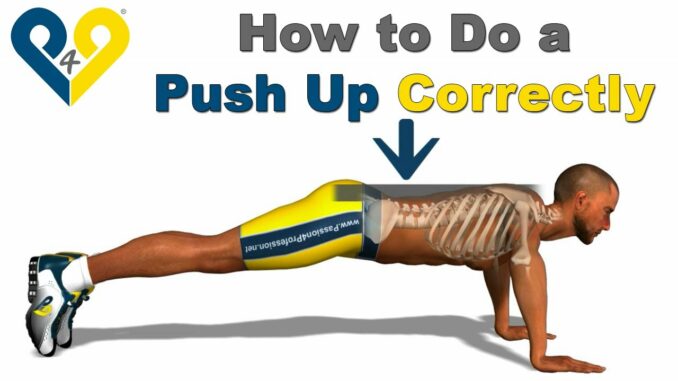
Performing a push-up correctly is fundamental to developing upper body strength and stability. It’s a compound exercise that engages multiple muscle groups, including the chest, shoulders, triceps, and core. Mastering proper push-up form not only maximizes effectiveness but also minimizes the risk of injury. Here’s a comprehensive guide on how to do a push-up correctly:
Understanding the Push-Up:
What is a Push-Up?
- Definition: A push-up is a bodyweight exercise that involves lowering and raising your body using your arms while maintaining a straight body position.
- Muscles Worked: Primary muscles include the pectoral muscles (chest), deltoids (shoulders), triceps (back of the arms), and core muscles.
Benefits of Push-Ups:
- Strength Building: Develops upper body strength and endurance, particularly in the chest, shoulders, and arms.
- Core Stability: Engages core muscles to maintain proper body alignment throughout the exercise.
- Convenience: Requires no special equipment and can be done anywhere, making it a versatile exercise for home workouts or travel.
Steps to Perform a Push-Up:
1. Starting Position:
- Position: Begin in a prone position (facing downward) on the floor or exercise mat.
- Hands: Place your hands slightly wider than shoulder-width apart, fingers pointing forward or slightly outward.
- Body Alignment: Maintain a straight line from head to heels, with your feet together or slightly apart.
2. Lowering Phase (Eccentric Phase):
- Engage Core: Tighten your core muscles to keep your body stable throughout the movement.
- Bend Elbows: Lower your body by bending your elbows, keeping them close to your torso at about a 45-degree angle.
- Depth: Lower yourself until your chest is just above or lightly touches the floor. Keep your head in a neutral position.
3. Pushing Phase (Concentric Phase):
- Push Up: Press through your palms to straighten your elbows and raise your body back to the starting position.
- Exhale: Exhale as you push up, maintaining control and keeping your body straight.
- Avoid Locking Elbows: Do not lock your elbows at the top of the movement to prevent joint strain.
4. Body Alignment Tips:
- Head and Neck: Keep your head aligned with your spine, looking slightly forward. Avoid dropping your head or lifting your chin excessively.
- Core Engagement: Tighten your abdominal muscles throughout the exercise to support your lower back and maintain stability.
- Hip Position: Avoid sagging or raising your hips; aim for a straight line from shoulders to heels throughout the movement.
5. Breathing Pattern:
- Inhale: Inhale as you lower your body towards the floor (eccentric phase).
- Exhale: Exhale as you push back up to the starting position (concentric phase).
6. Modifications and Progressions:
- Beginner Modifications: Perform push-ups on your knees (knee push-ups) to reduce resistance and build strength gradually.
- Advanced Variations: Increase difficulty by elevating your feet (decline push-ups), using resistance bands, or performing explosive push-ups (plyometric push-ups).
7. Common Mistakes to Avoid:
- Arching Back: Maintain a flat back and avoid arching or sagging your lower back during the exercise.
- Incomplete Range of Motion: Lower your body until your chest is close to the floor for full range of motion.
- Elbow Position: Keep elbows close to your body, not flaring out excessively, to protect shoulder joints.
- Speed: Perform push-ups slowly and controlled, avoiding rapid or jerky movements that can compromise form.
8. Incorporating Push-Ups Into Your Workout:
- Sets and Repetitions: Start with 3 sets of 8-12 repetitions, gradually increasing as you build strength.
- Frequency: Include push-ups in your workout routine 2-3 times per week, allowing muscles to rest and recover between sessions.
- Variety: Combine push-ups with other exercises for a comprehensive upper body workout, such as pull-ups, dips, and planks.
9. Progress Tracking and Goal Setting:
- Progression: Track your progress by recording the number of push-ups performed and gradually increasing repetitions or difficulty.
- Goals: Set realistic goals to improve strength and endurance, aiming to achieve more challenging variations or higher repetitions over time.
Safety Considerations:
- Consultation: If you have any medical conditions or concerns, consult a healthcare professional before starting a new exercise regimen.
- Warm-Up: Always warm up with dynamic stretches or light cardio before performing push-ups to prepare muscles and reduce injury risk.
- Cool Down: Stretch your chest, shoulders, and arms after completing push-ups to improve flexibility and aid muscle recovery.
Conclusion:
Mastering proper push-up form is essential for maximizing strength gains, improving muscle endurance, and preventing injury. By following these steps, focusing on correct body alignment, and gradually progressing in difficulty, you can perform push-ups effectively as part of a balanced fitness routine. Incorporate push-ups into your workouts regularly to reap the benefits of this versatile and effective upper body exercise.